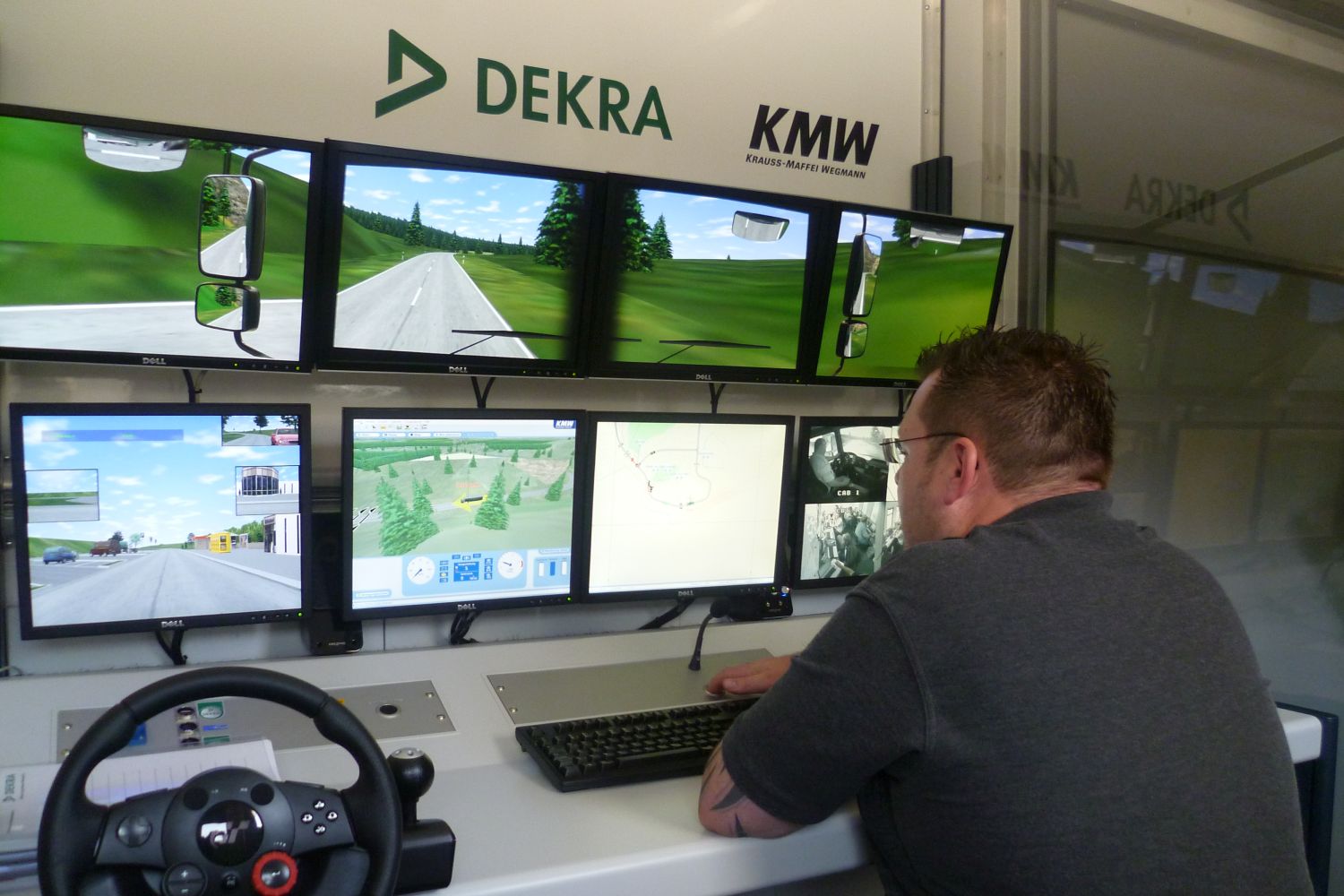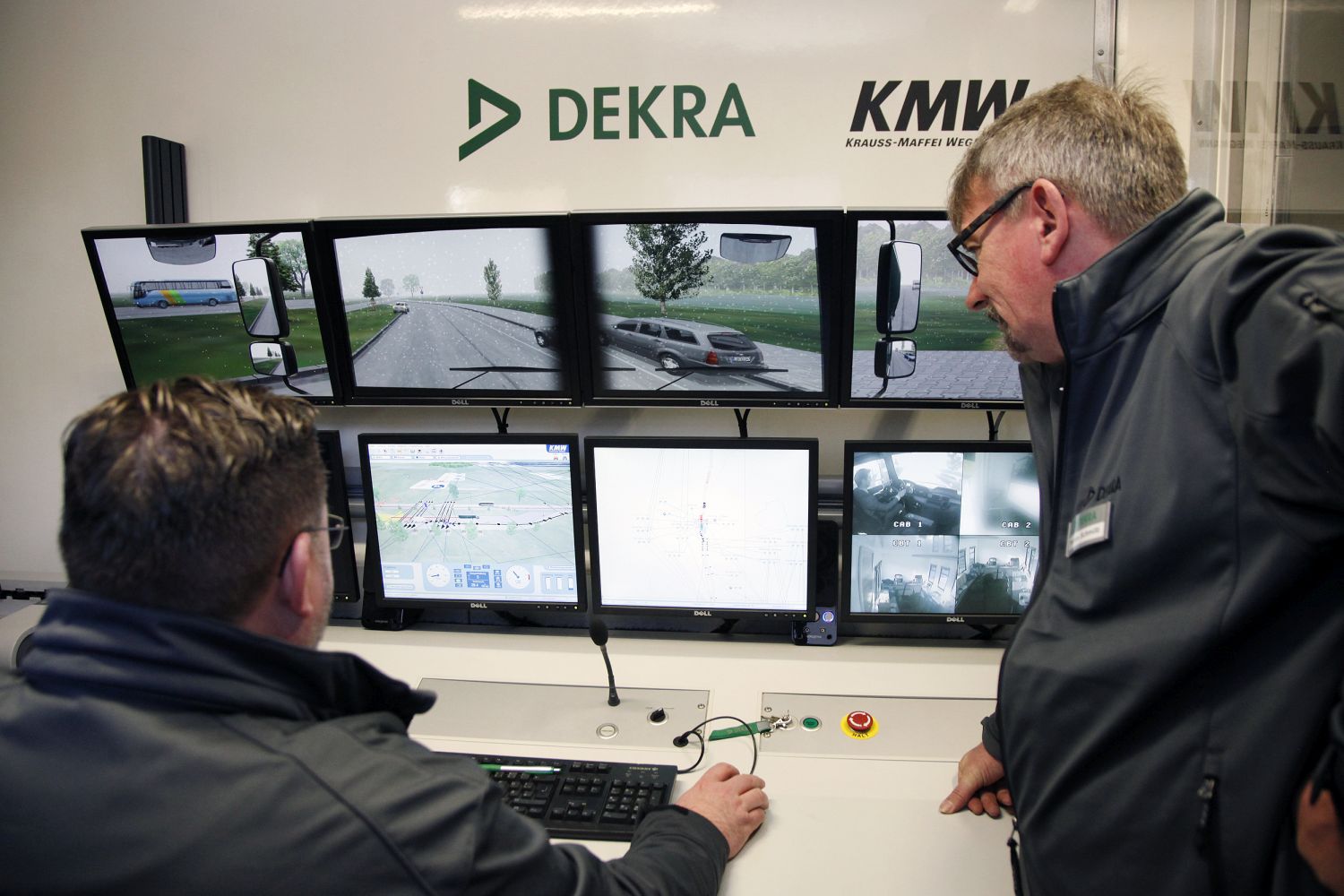Driving Simulator: Almost Real
Author: Joachim Geiger
How close to reality do simulators have to be to train professional drivers? Driving trainer Thorsten Straube has experienced professionals who were weak at the knees by the end of their driving lessons in the DEKRA driving simulator. Straube is now planning the next generation of mobile systems.
If a truck driver starts to sweat during training in accordance with the Professional Driver Qualification Act (BKrFQG), it may be because he is dealing with a particularly tricky driving task in the simulator. Driving a truck in a simulator? Some professionals may find this idea far-fetched – after all, the reality behind the wheel cannot truly be simulated! But what if it can? Thorsten Straube, project manager of the “ProFahrT” qualification program at the DEKRA Academy, knows more. During his assignments as a driving trainer, he deals with such reservations time and time again – and can ultimately prove most skeptics wrong. All it usually takes is a few minutes of driving time in the driving simulator built especially for DEKRA in 2010 by the Munich-based manufacturer Kraus-Maffei Wegmann (KMW). The mobile system is a high-end simulator with an original truck cabin mounted on a platform with six drives. This makes it possible to realistically reproduce cornering, acceleration, and braking situations, as well as driving on uneven terrain and over potholes. DEKRA uses the simulator for customers throughout Europe.
Sending a 40-ton truck with failing breaks into the emergency lane
“With our driving simulator, we can specifically train behaviors in critical and unpredictable situations,” explains DEKRA expert Straube. The program includes scenarios such as black ice in a bend, tire blowouts, and strong crosswinds. The driving trainer can also call up wildlife crossing the road, or cyclists and pedestrians suddenly appearing in front of the vehicle. “During an exercise some time ago, I sent a 40-ton truck with failing brakes into the gravel of an emergency lane. The driver was weak at the knees when he got out afterwards, and he said that he would never forget the experience,” recalls Straube. So does the performance of a simulator depend on its closeness to reality? And can this closeness be enhanced by the technology used? There seems to be some truth to this, as relevant studies have shown, including studies by the Technical University of Munich and the Federal Highway Research Institute (BaSt). On the other hand, the physical simulation parameters do not necessarily have to fully correspond to reality. The studies indicate that simpler driving simulators can also achieve results that are sufficiently close to reality. The European legislator has already embraced this insight. Directive (EU) 2018/645 of April 2018 stipulates that powerful simulators can replace part of the practical driving lessons for professional drivers’ initial qualification or further training.
DEKRA customers have the advantage of on-site training in the simulator
These days, the use of simulators in training and further education is state of the art across Europe. In addition to driving schools and training providers, some shipping agents and transport companies also rely on virtual training for the further training of their professional drivers – for example the Migros retail cooperative in Switzerland, or the international freight forwarder Nothegger in Austria. In Germany, DEKRA offers its customers the opportunity to complete modules on economical driving, driving safety, hazard assessment, and safety technology in the simulator. Most of the training takes place on the haulage companies’ premises. “This means zero emissions, zero damage to the fleet, and no journeys for the drivers,” says Straube, summing up the advantages. Another field of work for the simulator is special training – such as anti-rollover training for tanker drivers on airport aprons. The mobile system is also popular with police and emergency services for training their emergency runs with flashing lights. On average, the DEKRA simulator is used by customers on around 100 days per year. That is quite a lot when you consider that one day of training usually involves two days of travel to and from the site. The bottom line is that the journeys to customers and appearances at trade fairs and events add up to around 40,000 kilometers per year.
A new driving simulator to go into operation
Even though many more kilometers may be added over the next few years – the days of the mobile DEKRA driving simulator are numbered. In fact, Thorsten Straube is already working on the specifications for a completely new system, which is due to go into service at the DEKRA Academy in the medium term. The reasons are obvious: Even if the current driving simulator can still be considered a top product, it is no longer up to date. After all, commercial vehicle technologies have made a huge leap forward in recent years – also in regard to electronic assistance systems. At the same time, a great deal has happened in the development of simulator technology. So where could the journey take us now? Straube sees great potential in new motion systems.
“We attach great importance to a system that enables fast and precise movements in order to achieve a realistic representation of vehicle dynamics,” explains Straube. To achieve this goal, it is no longer necessary to set the entire cab in motion, but only the driver’s seat. All it takes is a few actuators fixed directly to the seat. Top products can transmit vibrations, shocks, and acceleration forces directly to the driver’s seat – automatic emergency braking, for example, could be simulated almost perfectly.


The software decides on a realistic design of the environment
A modern graphics engine is also high on the list of requirements, with which the interaction between driver, vehicle, and traffic environment can be designed realistically in the virtual world. The driving simulation software plays a central role. A high-quality design of scenarios with extensive buildings and realistic road widths and curve radii helps the test person to perceive the simulator environment almost like reality. The simulated vehicle’s behavior is based on sophisticated physical models, while the behavior of road users in the respective scenarios is based on the latest traffic simulation models. The icing on the cake of highly developed simulation software would be a sound model that simulates the sounds of the simulated vehicle and of other road users. With this additional information, the driver could even better assess the current traffic situation in the simulator.
For Thorsten Straube, it is ultimately only logical that the new concept for the DEKRA driving simulator should also focus on mobility. The expert finds the previous solution with a complete articulated truck to be too big. Straube has established that the simulator’s truck cabin could also be accommodated in a larger car trailer with an appropriate extension. In that case, a handy van could take over instead of a tow car with a trailer. The benefit would be significantly more flexibility and lower transportation costs.
High-performance driving simulators in Europe
The European market for high-performance driving simulators is comparatively small. In Germany, companies such as SiFaT RoadSafety (Berlin) and SimuTech Gesellschaft für Fahrsimulation mbH (Bremen) offer simulators in original truck cabins with corresponding motion platforms. The simulators from Ediser are built in the French cities of Marseille and Montpellier, while Polish company Autocomp Management from Szczecin is continuing the history of the KMW simulator in cooperation with Kraus-Maffei Wegmann. Also from Poland comes manufacturer Motion Systems from Nadolice Wielkie with its TS-10 truck simulator, which is based on the use of a Mercedes cabin. In San Sebastián, Spain, the company Lander Simulation & Training Solutions is committed to developing customized simulators for the training of professional drivers.

